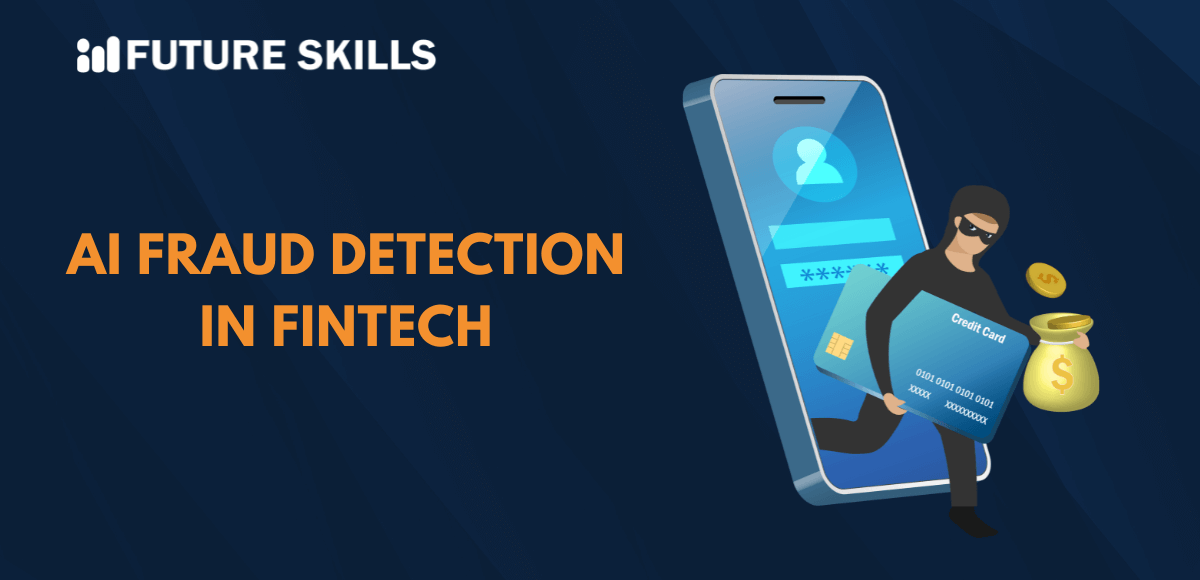Fraud isn’t some once-a-year headline anymore; it’s practically part of the daily news feed for anyone with a debit card. Financial apps now flip money around at a breakneck pace, and every ping of a notification adds another chance for a scammer to sneak in. Regulators and bank tech teams talk about the data storm as they scramble toward one hot buzzword: AI fraud detection in fintech. As a result, financial institutions are urgently turning to advanced solutions like AI fraud detection in fintech to stay ahead of the threat.
These days a fraudulent buy may show up as a dime here and by the end of the month you’re scratching your head at a surprise. Hackers no longer blast a single huge hit; they tap, dodge, and reset their trail so no one can track. To stay even, transaction engines need something that doesn’t just think once but keeps scanning every transaction. AI-powered fraud detection systems perform better than any human ever could.
Level up your AI skills and embark on a journey to build a successful career in AI with our Certified AI Professional (CAIP)™ program.
Why Traditional Systems are No Longer Enough
Traditional systems might still be used on bank servers with blinking lights, churning out alerts that feel smart. The trouble is, those thresholds line up neatly for the first scam and then get tricked by the second one five minutes later. A fraudulent spreads tiny buys across ten IDs, blinks once, and nothing gets flagged. By the time a human recalls the incident, the thief has already moved the money.
This is where fraud detection using AI in banking becomes a game-changer. Unlike the old, one-size-fits-all filters, these smart models scan every transaction on the spot and instantly compare it to years of past data. They learn with every click, so they can sound the alarm even if they’ve never met that type of scam before. Take a shopper who’s been silent for months and then suddenly splurges on sky-high airline tickets from three different countries in an afternoon; the system can freeze the purchase before anyone presses final approval, and it does that even when the charge falls beneath every hard-coded limit.
On top of that, intelligent layers keep stacking insight upon insight. The software weighs context, timing, the kind of smartphone in use, and a dozen other hints to build a bear-live risk map that sharpens with every swipe.
How Machine Learning Powers Modern Fraud Detection
Machine learning fuels much of this progress by spotting patterns at unbelievable speed. Engineers feed the algorithms millions and millions of known-good and known-bad records, and the code begins to notice tiny clues that slip right past people or static checks. In that sea of data, the system discovers, let us say, very slight differences between legitimate late-night coffee shop purchases and fraudulent runs on stolen cards-and it learns to flag those differences 24/7 without human hand-holding.
Fraud detection using machine learning focuses on pattern recognition at scale. Instead of logging a user by a single click, the software stacks that action next to hundreds of older clicks, folders of peer habits, and even a silent fingerprint from the device. One odd step-log in from a fresh IP while the phone still pretends to be on a VPN-can yank trust down to near zero and prompt a pesky extra code.
People hate false alarms almost as much as they hate crime itself. Too many dumb beeps drain patience and quietly ruin faith in the bank app. Over time the number-crunchers learn to chill the sirens, nabbing real crooks while letting everyone else slide through with a nod and a smile.
Enroll now in the Machine Learning Essentials Course to explore the implications of supervised, unsupervised, and reinforcement learning in diverse real-world use cases.
Real-Time Threat Response in Fintech Systems
When discussing fintech fraud detection, speed is everything. Bills pile up in mere heartbeats, so stopping a sketchy transfer before a second cup of coffee cools is non-negotiable. AIs sitting inside the plumbing chew through terabytes in the time it takes a thumb to tap twice, flipping every twitch of activity into a fraud score before the send button even feels pressed.
For example, a mobile wallet notices you trying to send money to a sketchy account at 3 a.m., and drumrolls you’re using a brand-new phone the app has never met. In less than a heartbeat, the wallets real-time AI runs the numbers, weighing your past behavior, the odd hour, and the device’s fingerprints against its gut feeling.
The payment gets iced before you even blink. Then, like a security guard who won’t let you through without a badge, the app forces a tougher ID check, maybe a face scan or an old-school callback. Pass that mini-obstacle course and your cash sails out; fail, and the transfer freezes for good.
Understand how fintech is revolutionizing finance and develop a career with our Fintech Certification Program. Enroll now!
The Strategic Benefits of AI Fraud Detection in Fintech
Implementing AI fraud detection in fintech isn’t just about technology, it’s a business advantage. Fintechs that wire this magic into their systems earn happier customers, keep regulators off their backs, and build operations that shrug off daily shocks.
Moving to AI fraud protection feels more like hiring a brilliant analyst than flipping a switch on new code. Organizations that plug in this smart tech shave off scam losses, lighten the pile of manual reviews, and wind up with buyers who actually smile when things go wrong, if they even notice at all. On top of that, these systems dance with changing privacy laws and cybersecurity playbooks, letting banks and wallets claim they are keeping data safe, because they usually are.
Fintech apps succeed or fail on one simple thing that people have to feel safe. When users see constant lockouts or discover a big security hole, they hit the uninstall button faster than you can say bank transfer. A product that protects money while letting customers move, check, and spend with almost no friction tends to stick around. Smarter systems lean on AI that spots real alarms and quiets the false beeps. That kind of automatic learning keeps the security team from playing whack-a-mole all day.
Emerging Trends: Collaborative Intelligence and Federated Learning
As financial ecosystems grow more interconnected, the next phase of fraud detection using AI in banking includes collaborative intelligence models. Consider lots of banks texting each other in secret about new scam patterns they’ve spotted. A wallet here shares a sketch of a sketch, a lender there chips in a different angle, and together the machines get much better at spotting the next ripple. It turns ordinary competition into a neighborhood watch for digital dollars.
Then there is federated learning, which sounds techy but really tries to keep your data in your pocket. AI models sit on their own servers, polish themselves with tips they picked up locally, and only swap summary notes. Your transaction detail never crosses a firewall, yet the overall system tightens up. That level of careful privacy is a must when fintech plays in markets with wildly different rules. So as protections pile on, people can keep using their favorite apps without thinking the floor might drop out.
Level up your ChatGPT skills and kickstart your journey towards superhuman capabilities with Free ChatGPT and AI Fundamental Course.
Challenges and Ethical Considerations
Artificial intelligence has turbocharged the fight against fraud, but it isn-t some magic bullet. Every model learns from the data it eats; it serves biased or thin information and it might unfairly punish honest customers or miss sly scams altogether.
Even scarier, con artists watch the software, poke at its weaknesses, and tweak their tricks until the shiny new model looks stale. That constant game of cat and mouse keeps teams scrambling for an edge.
To keep the damage low, banks and fintech firms retrain their systems on fresh data and ask real humans to take a second look at the oddball cases. Regular audits check whether the predictions hold up, and plain language explanations show customers and regulators why a transfer got flagged.
Final Words
AI fraud detection in fintech isn’t merely an upgrade; it’s a completely new strategy.
By analyzing context on the fly, saying yes or no in seconds, and adjusting rules while attacks unfold, AI catches scams that old systems let slip. Whether you’re tackling fraud detection using AI in banking or deploying fraud detection using machine learning across digital wallets, the message is clear: staying ahead of fraudsters requires staying ahead in technology.
Fintech companies are waking up to the fact that AI isn’t a nice-to-have anymore. Scam artists keep upgrading their tricks, and only smarter software can keep those tricks from slipping through the cracks. Today’s finance safety net is being knitted right around an artificial-intelligence core. Learn more about AI-powered fraud detection systems to enhance your knowledge and get ahead in the AI-driven world.






